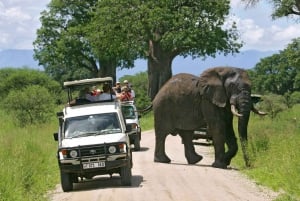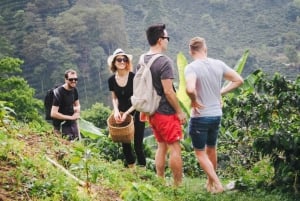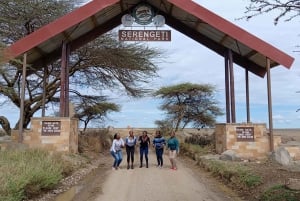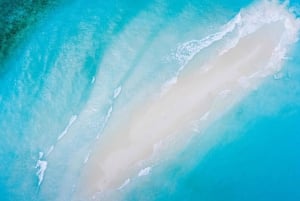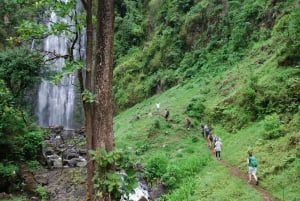National Parks

In spite of its proximity to Arusha town, Arusha National Park, is little visited, despite offering the opportunity to explore a beguiling diversity of habitats within a few hours.
Dominating the park is the volcanic Mount Meru, Tanzania’s second highest mountain. The national park and its fringing forest reserve encloses much of the mountain, including 3.5km wide Meru Crater on the summit and the entire eastern slope...

Just 16km north of Kigoma, Gombe Stream is the smallest but one of the most inspiring of Tanzania's national parks. Its 52 square kilometre narrow strip is a fragile chimpanzee habitat straddling the steep slopes and river valleys that hem in the sandy northern shore of Lake Tanganyika. Its chimpanzees – habituated to human visitors – were made famous by the pioneering work of Jane Goodall, who in 1960 founded a behavioural research program that now stands as the longest-running study of its kind in the world...

Katavi National Park, 35km south of Mpanda, and 143km north of Sumbawanga, covers 4471 square kilometers, making it Tanzania’s fourth-largest protected wildlife area. Isolated, untrammelled and seldom visited, Katavi is a true wilderness.
Whilst the national park doesn’t have especially spectacular scenery, its extraordinarily rich dry-season wildlife viewing, when vast quantities of game concentrate around rapidly...

The Kipengere Mountain Range, comprising much of the region between Mbeya and Njombe, contains areas of immense ecological importance, notably the remote grasslands of a highland plateaus now protected as Kitulo National Park.
Kitulo is indeed a rare botanical marvel, home to a full 350 species of vascular plants, including 45 varieties of terrestrial orchid, which erupt into a riotous wildflower display of...

Set against the impressive 600m-high backdrop of the Great Rift Valley’s western escarpment, Lake Manyara National Park, which covers the lake’s northwestern corner, is a rare flash of green in an otherwise unremittingly dry land.
The compact game-viewing circuit through Manyara offers a virtual microcosm of the Tanzanian safari experience. Much of the parks’ land area is covered by groundwater...

Located 120km south of Kigoma on wide peninsula jutting out into Lake Tanganyika, Mahale Mountains National Park is one of the country’s least visited parks. Covering 1613 square kilometers, it’s dominated by the heavily forested Mahale Mountains, which rise up from the sandy beaches on the lakeshore to the peak of Mount Nkungwe.
Mahale Mountains is home to some of Africa’s last remaining wild chimpanzees: a...

An hour’s drive southwest of Morogoro, Mikumi National Park abuts the northern border of Africa's biggest game reserve - the Selous – and is transected by the surfaced road between Dar es Salaam and Iringa. Framed by the Uluguru, Rubeho and Udzungwa Mountains, Mikumi’s grassy plains and thick miombo woodland is an oasis for wildlife.
Lions survey their grassy kingdom – and the zebra, wildebeest, impala and buffalo herds...

Tanzania’s newest national park, Mkomazi was only gazette in 2008 and is still sees few visitors. At the moment the wildlife is rather sparse, but TANAPA has high hopes for the scenic stretch of baobab-studded savanna adjoining Kenya’s giant Tsavo National Park.
Set below the verdant slopes of the spectacular Usambara and Pare Eastern Arc Mountain ranges and overseen by Kilimanjaro, Mkomazi adds to the fulfillment of high...

Kilimanjaro National Park covers the entire mountain above the tree line, together with six forest corridors running down to around 2000m.
Kilimanjaro, not only is this the highest peak on the African continent; it is also the tallest free-standing mountain in the world, rising in breathtaking isolation from the surrounding coastal scrubland – elevation around 900 metres – to an imperious 5,895 metres...

Ngorongoro Conservation Area occupies the volcanic highlands between The Great Rift Valley and the Serengeti Plains. It’s the product of the volcanic upheavals that accompanied the formation of the Rift Valley, and its varied habitats virtually guarantee sightings of "the big five" – elephant, lion, leopard, rhino and buffalo.
The Ngorongoro Crater is called "The Eighth Natural Wonder of the World," and a visit to...

Straddling the Eastern Rift Valley west of Iringa, and covering over 20,000 square kilometers, Ruaha is Tanzania’s largest national park, and one of the least visited. Ruaha protects a vast tract of the rugged, semi-arid bush country that characterises central Tanzania. Its lifeblood is the Great Ruaha River, which courses along the eastern boundary in a flooded torrent during the height of the rains, but dwindling thereafter to a scattering of precious pools surrounded by a blinding sweep of sand and rock.

Tucked in to the Lake Victoria’s southwestern corner, Rubondo Island National Park is one of Tanzania’s least-visited and best-preserved wildlife areas. With nine smaller islands under its wing, Rubondo protects precious fish breeding grounds.
Tilapia form the staple diet of the yellow-spotted otters that are found in the island’s rocky coves, while Nile perch, some weighing more than 100kg tempt recreational game...

The rarely visited 1062 square kilometer Saadani National Park, 45km north of Bagamoyo is unique in combining marine, terrestrial and riverine environments. Saadani is where the beach meets the bush and is also the one place in Tanzania where an elephant or lion can be seen on a beach.
Protected as a game reserve since the 1960s, in 2002 it was expanded to cover twice its...

Located in south-east Tanzania in a remote and little-visited part of the country, the Selous Game Reserve is Africa’s largest protected wildlife reserve and covers more than 5% of Tanzania’s total area. Its rivers, hills, and plains are home to roaming elephant populations, the area’s famous wild dogs, and some of the last black rhino left in the region.
The Rufiji River Delta is a striking feature of the game reserve. It connects the Great...

As one of the world’s most famous wildlife areas, the Serengeti needs little introduction. Bordering Ngorongoro in the east, Kenya’s Maasai Mara Game Reserve in the north reaching to within 8km of Lake Victoria in the west, the Serengeti is also Tanzania’s largest national park.
Tanzania's oldest and most popular national park, also a world heritage site and recently...

Singita Grumeti Reserves offers an unparalleled eco-safari teeming with magnificent wildlife encounters on the western corridor of the Serengeti. This vast private concession comprises an exclusive trio of luxury lodges positioned ideally on the epic migratory route traversed annually by more than a million wildebeest. If it is solitude you seek then Singita Grumeti Reserves is the place to be!

Occupying almost 4,000 square kilometers of pure Rift Valley wilderness southeast of Lake Manyara, Tarangire comprises Tarangire National Park and the adjacent Tarangire Conservation Area.
Herds of up to 300 elephants scratch the dry river bed for underground streams, while migratory wildebeest, zebra, buffalo, impala, gazelle, hartebeest and eland crowd the...

It’s difficult to do justice to the wonder that is Udzungwa Mountains National Park, an immaculate forest-cloaked wilderness whose 1,900 square kilometers are among the most diverse on earth. Udzungwa is the largest and most biodiverse of a chain of a dozen large forest-swathed mountains that rise majestically from the flat coastal scrub of eastern Tanzania. Known collectively as the Eastern Arc Mountains, this archipelago of isolated massifs has also been dubbed the African Galapagos for its treasure-trove of endemic...




